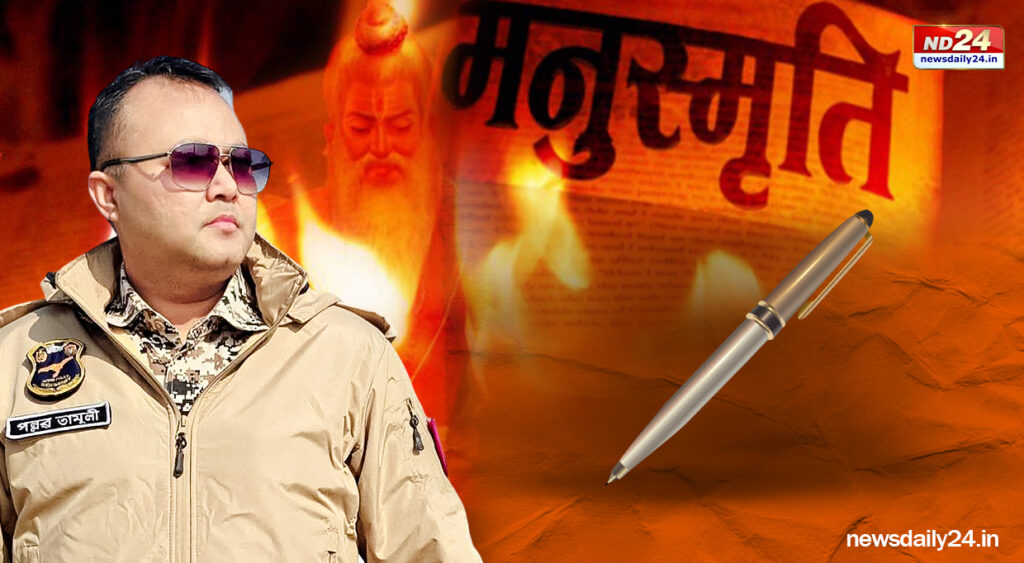The Manusmriti, attributed to Sage Manu around 200 BCE, stands as one of the foundational texts of Sanatan Dharma. It is not merely a legal code but a comprehensive guide that outlines the moral, social, and legal framework for a harmonious society. For centuries, these principles have shaped the ethical and social structure of Indian civilization, encompassing diverse aspects of life – from studenthood, household responsibilities, and ascetic life to food habits, governance, and moral conduct.
Among its most debated aspects is the role and status of women. Critics, especially from Western and leftist ideological backgrounds, have often portrayed the Manusmriti as a misogynistic text, focusing selectively on certain verses while overlooking its broader teachings on respect and honor for women. However, a deeper and more balanced reading reveals that the Manusmriti seeks to uphold the dignity and security of women within the framework of a stable society.
Women and Protection: A Misunderstood Principle
One of the most frequently cited and misinterpreted verses from the Manusmriti is: “A woman should be protected by her father in childhood, by her husband in youth, and by her sons in old age. She should never be independent.” (Manusmriti 5:148)
At first glance, this verse appears to endorse control over women, but the intention behind it reflects the social realities of ancient India. In a time when society was structured around extended families and communal living, protection was not about subjugation but about ensuring security and well-being. Even today, the responsibility for the safety and welfare of women often falls on the family. This verse highlights the familial responsibility to protect women from harm and ensure their comfort and dignity throughout life.
Protection does not imply domination – rather, it reflects the sacred duty of family members to safeguard and nurture the women in their lives. This protective framework ensured that women were not left vulnerable in a society where external threats and instability were common.
Honour and Reverence for Women
Far from diminishing the status of women, the Manusmriti elevates them as bearers of honor and spiritual wisdom. A striking example is the following verse:
“A Brahmin should first show reverence to his mother, then to his teacher, and then to his father, for the mother is the first teacher and guide.” (Manusmriti 2:50)
This verse reflects the high position of the mother in Sanatan society. The mother is regarded not only as a life-giver but also as the first guru (teacher) who introduces a child to the moral and spiritual order. This reverence for the mother embodies the sacred feminine principle (Shakti) that underpins Sanatan philosophy. The divine is often portrayed as feminine, and this understanding naturally extends to the respect given to mothers and women in general.
Another verse further reinforces this sacred perception of women: “A wife of another man should be regarded as one’s mother.” (Manusmriti 2:129)
This teaching promotes a culture of respect and purity in interpersonal relationships. If every man views women with the same reverence and sanctity as he does his mother, the foundation for a harmonious and morally upright society is laid. In an age grappling with increasing crimes against women, these teachings hold profound relevance as guiding principles for cultivating a culture of respect and dignity.
The Sacred Role of Women in Society
The Manusmriti not only advocates for the protection and reverence of women but also ties the very fate of society to how women are treated. It states:
“Where women are honored, the gods reside and bestow blessings. Where women are dishonored, all efforts become fruitless.” (Manusmriti 3:55–56)
This profound teaching underscores that the prosperity and spiritual strength of a society are intrinsically linked to the status and treatment of women. When women are respected and empowered, society flourishes; when they are dishonored, it descends into chaos and moral decay. This reflects the core Sanatan belief that the feminine principle (Shakti) is the driving force behind creation, stability, and harmony.
The role of women as caretakers, spiritual guides, and moral anchors is not a position of subjugation but one of immense responsibility and honor. The ancient reverence for goddesses like Durga, Lakshmi, and Saraswati is mirrored in the respect afforded to women within the social structure outlined in the Manusmriti.
The Legacy and Misinterpretation of Manusmriti
Over time, certain verses of the Manusmriti have been selectively criticized and misrepresented, often with the intent of portraying Sanatan society as regressive and patriarchal. Western colonial narratives and leftist ideologies have played a significant role in this distortion. However, the Manusmriti must be viewed within its historical and cultural context.
The framework of protection, reverence, and moral order provided by the Manusmriti aimed to ensure societal stability and spiritual elevation. Far from being a tool for oppression, it served as a moral compass guiding interpersonal relationships, governance, and social harmony.
Efforts to erase the Manusmriti from Indian consciousness before independence were driven by a colonial agenda to undermine the foundations of Sanatan culture. By reviving its positive teachings and understanding its true intent, we can reclaim a balanced and dignified approach to the role of women in society.
Conclusion: The Eternal Wisdom of Manusmriti
The Manusmriti is not a relic of the past but a living document of ethical and moral guidance. While certain verses may appear outdated when viewed through a modern lens, the underlying principles of protection, honor, and reverence for women remain timeless.
By understanding the Manusmriti in its true essence – not through the lens of selective criticism but through the wisdom of its teachings – we can restore the values of respect, security, and dignity for women in society. The protection and reverence accorded to women in the Manusmriti reflect the sacred role of the feminine in Sanatan Dharma – as nurturer, protector, and source of spiritual strength.
The path to a harmonious and prosperous society lies not in rejecting the Manusmriti, but in rediscovering its profound insights and adapting them to the needs of the modern world. By upholding these eternal values, we honor the legacy of Sage Manu and the enduring wisdom of Sanatan Dharma.
(Pallav Tamuly is an Assam Police Service officer. The views expressed in this article are those of the author and do not necessarily reflect the views of ND24 or its affiliates)







